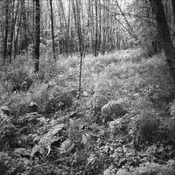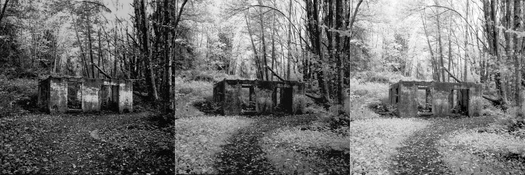Ivo Stunga
Member
Yup, and I love infrared in overgrown abandoned premises where nature takes over - that looks gorgeous to my eyes. Should've metered it at ~160 though
The trickiest part of working with NIR, is predicting the effects of reflected light. If there is a lot of vegetation around, there is potentially a lot of reflected NIR, and you really cannot see that effect with your eyes. It is also what gives you the sometimes surprising and unexpected results, which is part of the fun of shooting IR film.
One does not need to worry about the results just:
- Shoot on a sunny day with grass and leaves.
- Conifer needles do not throw off the heat so look for diciduous trees with lots leaves.
- Backlit subject generally do not show the IR well, so have the bright sun behind you.
- The sky and water will usually look dark or black depending on the filter, so look to vegetation that will have a bright contrast with the sky and water.
- Leave the mostly shadow compositions for non IR film.
- Buy and use different filters for different effects. I use Red23, Red25, Red29 and 720 [Red 72].



If you are limiting yourself to sunny days, you are missing out on a lot of the great opportunities that near IR capable films offer, These are all using Ilford SFX. The triptych shows the results of SFX without a filter and exposed and metered at the box speed of 200, SFX with an R72 filter metered at box speed and exposed at the reading plus 6 stops, and SFX with an R72 filter metered at box speed and exposed at the reading plus 9 stops:
View attachment 341033
View attachment 341034
View attachment 341035
I just scanned my test negatives, and iso 50/3 stops looks good for the overcast conditions I had. One shot with a lot of sky even looks good at 100. I was guessing a bit on development, but the package insert said 10:50 with d-76 1:1, so I used Sprint developer as an equivalent and adjust my time to 8:30 at 70 degrees.
Is anyone able to upload images here, or do I need a paid memebership? That might give us some more info to discuss.
Rollei IR 400 has the box speed of ISO 400. Use that, I have for years and never had a problem. The filter factor in f/stops for the four "Red" filters are
Red23....2 f/stopsRed25....3 f/stopsRed29....4 f/stopsRed72...5 f/stopsI found that it is better to use the box speed and then adjust for the filter. That is always accurate and avoids problem is you expand to use other Red filters besides Red72 aka 720. Starting with the adjusted ISO can led to problems when switch filters or when adjusting for shadow details or both. Use box speed and keep it simple.
OK, you convinced me to look at shady locations for using IR film. I will try it with more f/stops in the exposure time.
I think that Adox HR-50 (Scala) may be the best IR film for 35 mm. To my eye, its IR sensitivity is almost as good as IR 400. Since the effective speed of IR 400 is likely less than 100, the difference in speed may not really be that much. One usually shoots IR on a tripod anyway, so slight differences in speed are less important. But HR-50 has vastly finer grain than IR 400; it's one of the finest grain films available. HR-50 also benefits from Adox's Speed Boost treatment which mitigates the extreme "S" shaped curve that plagues the aero films.
Try using remote powerful flashes placed at points of interest with high sync speed and slight underexposure of the ambient.
That can give some amazing effects.
I think that for making IR shots adjusting exposure from E.I. 400 the way you describe will work, but not because 400 is realistically the box speed of the film. In a sense, one could start with any arbitrary E.I. like 800 or 1600 and it could work if one adjusted the exposure proportionally. My understanding is the film is Agfa Aviphot 200, so it cannot attain 400 speed. Hennings Serger says the effective E.I. is less than 100. This would matter if not making IR shots.
Except after having perfect the use of flash years ago and used it for a long time, I only use available light photography and my expensive strobe sits at home without its batteries. Also I have never had an IR strobe.
If the shot at 50 is the one in your lower post of the boat, grass and foliage then that's a pretty good "Wood Effect" for an overcast day. especially at 50
pentaxuser
Yup, and I love infrared in overgrown abandoned premises where nature takes over - that looks gorgeous to my eyes. Should've metered it at ~160 though
Thanks! Knowing that there's always IR light out there, I approach it as any other film and just experiment around with decent results and boatload of learning in the process.I would not have thought to use it in such a setting.
I use IR film in various lighting conditions, in various times of the day, all year round, cloudy, sunny...
I almost always use a 720IR, but sometimes a #29 is appropriate. I sometimes work at EI 6, or 3 with the 720 filter. I use a 1° spot metre and base exposure on a shadow, placing it usually on Zone 3. I can then check where highlights fall to assess scene brightness range, and develop accordingly. Foliage is left to fall wherever on the zonal scale. Focus correction is not necessary with current IR films. I sure do miss 4x5 HIE. The strongest filter I used on that film was a #25. Even with a yellow #12, one could get Wood Effect.
All we need is an ortho film with IR dyes and no AH layer.

| Photrio.com contains affiliate links to products. We may receive a commission for purchases made through these links. To read our full affiliate disclosure statement please click Here. |
PHOTRIO PARTNERS EQUALLY FUNDING OUR COMMUNITY:  |